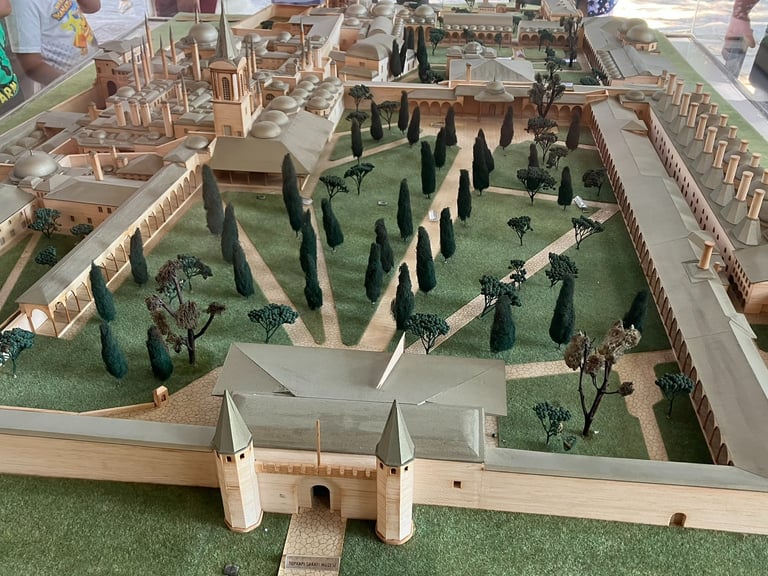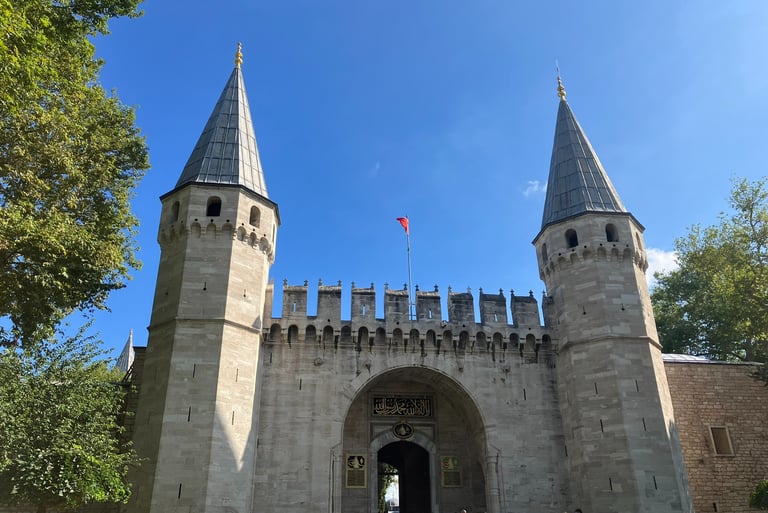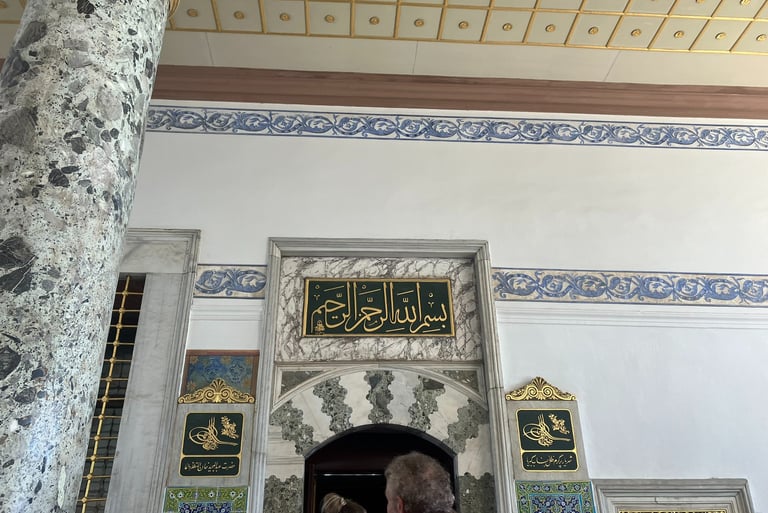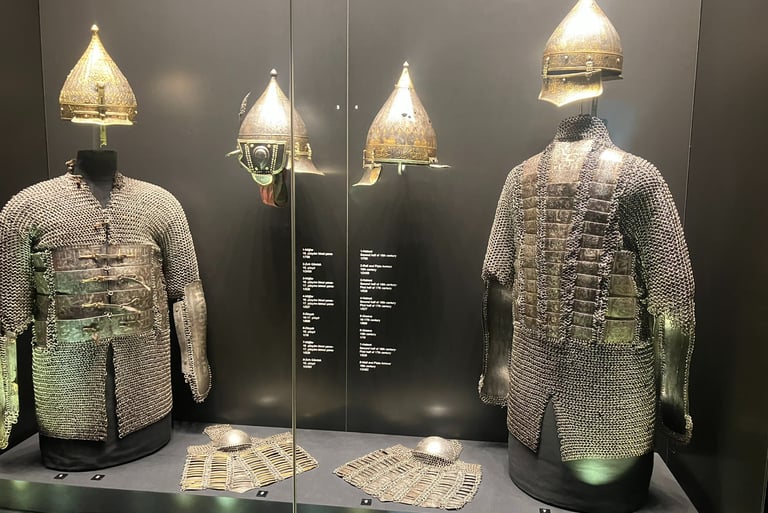Nomad Journey 3
Topkapi Palace Türkiye
4/5/20257 min read


بِسْمِ ٱللَّٰهِ ٱلرَّحْمَٰنِ ٱلرَّحِيمِ
Visiting Topkapi Palace was one of the highlights of our trip to Istanbul. This historic landmark, once home to Ottoman sultans, offered a fascinating glimpse into the past. With its stunning architecture, lush gardens, and incredible treasures, the palace made for an unforgettable day of exploration and discovery.
Whether you are interested in Islamic history, architecture, or spirituality, Topkapi Palace is a must-visit destination for Muslims around the world. It reminds us of the strength, dignity, and depth of our past. In a time when reconnecting with Islamic values is more important than ever, Topkapi offers a powerful reminder of the glory of Islamic civilization.
Nestled in the heart of Istanbul, Topkapi Palace stands as one of the most significant symbols of the Islamic world’s rich history. For nearly 400 years, this majestic palace served as the administrative center and royal residence of the Ottoman Empire, one of the greatest Islamic empires in history. For Muslim travelers and history enthusiasts, Topkapi is not just a tourist attraction—it's a spiritual and cultural journey into our shared heritage.
Topkapi Palace was commissioned by Sultan Mehmed II (Mehmed the Conqueror) in 1459, shortly after his historic conquest of Constantinople in 1453. The palace became the seat of the caliphate and home to successive Ottoman sultans. These leaders not only ruled vast territories across three continents but also served as custodians of Islamic tradition and law. The palace functioned as the heart of Islamic governance, where decisions that shaped the Muslim world were made.
Our day started early as we wanted to get as much done before it got too hot. The palace is not far from Sultan Ahmed Square, so you can take a long walk, but considering that you will have to walk a lot in the palace itself, I would suggest taking the tram. The tram was very useful to the rest of our trip, so I would suggest purchasing a tram card and loading it with a little money, depending on how many people you are traveling with. It is easy to use but does get busy during especially at peak hours, so time yourself carefully so that you are not on during 9-10 am or 4-5 pm to avoid the working commute.
The palace itself opens at 9 am and closes around 5 pm, and is completely closed on Tuesdays, so plan your visit and check updated hours online before going. I purchased my ticket at the palace, which is the cheapest(about $40 per person at the time we went), be careful not to book with 3rd party online sellers as you will get charged much more. You can visit all the places in the palace for this fee except the hareem section, which we didn't visit. If you want, there are guided tours which can be a benefit, but we preferred to explore and learn ourselves by doing some research before. Many sections of the palace are worth exploring depending on how much time you have which I have detailed below, but my suggestion is that you get there early and go straight to the Holy relics section as it is the highlight but gets very busy by about 11 am and you don't want to be rushed through it. Don't forget to pack some snacks and water. There is a lot to reflect on as a Muslim, and it's nice not to be rushed, especially with kids. There are maps along the way to see where you are and guide yourself to where you want to go. We spent almost the whole morning there and couldn't visit everything:
Our journey began at the Imperial Gate(Bab-ı Hümayun), the grand entrance leading into the palace grounds. Built in the 15th century, the gate is inscribed with Arabic calligraphy and Quranic verses, reflecting the deeply Islamic nature of the Ottoman state. As a Muslim visitor, pause to appreciate how Islamic art and state power were intertwined from the very entrance.
The Third Courtyard (The Inner Palace) is the heart of Topkapi Palace. It includes the Sultan’s private chambers and the Imperial Treasury, but most importantly, the Chamber of the Sacred Relics. This is a deeply spiritual area where Muslims can view many items of significance from our beloved Prophet(peace be upon him) and companions(Allah be pleased with them). Now according to a local historian we know the relics from the time of our Prophet(peace be upon him) and after that are generally considered all legitimate as the Ottomans ruled the Harams and head of the Islamic state for so long they cataloged these, but hard to say about the relics from before that so best to say we don't know for sure. The Qur’an is recited continuously in this room in the beautiful Turkish style. If there is only one place in the palace grounds you are going to visit, this should be it.
The Imperial Treasury displays opulent items like the Topkapi Dagger, emerald-encrusted Qur’ans, and other artifacts that reflect both Islamic craftsmanship and royal aesthetics. These items were often commissioned to honor the beauty of Islam and showcase the blessings bestowed upon the Muslim world.
The First Courtyard (The Courtyard of the Janissaries) was home to the elite Janissary corps, who were not only soldiers but also devout Muslims trained in Islamic principles. Here you'll also find the Hagia Irene Church, a pre-Ottoman structure that the Ottomans preserved rather than demolished—showcasing their respect for historical continuity.
The Second Courtyard (Divan Square) the key highlight is the Divan (Imperial Council Chamber) is a key highlight. This is where viziers and officials would gather to govern the empire based on Sharia law and Ottoman administrative codes. Look for the Tower of Justice (Adalet Kulesi), symbolizing the sultan’s role as a protector of justice in line with Islamic teachings.
The Palace Kitchens and Islamic Cuisine section was really interesting for us, being foodies and home cooking lovers. It was really interesting to see what utensils they used to both cook and serve food. The palace kitchens once prepared meals for over 4,000 people daily—all in accordance with halal dietary laws, of course. They also housed a vast collection of Chinese porcelain, as it was believed to detect poison, reflecting the Islamic value of preserving life. This area reveals how deeply Islamic principles permeated even culinary traditions. There are porcelain sets from all over the world to view different types of styles from other empires and cultures during those times.
The Library of Sultan Ahmed III is a beautifully preserved library that contains thousands of Islamic manuscripts, many of which are Qur’ans and Hadith collections. As a Muslim, it’s inspiring to witness the reverence the Ottomans held for Islamic knowledge. The library itself is adorned with Quranic verses and stunning Islamic calligraphy.
The Imperial Armory was our second favorite part of the visit and showcases a stunning collection of Ottoman and Islamic weaponry, including intricately decorated swords, daggers, bows, shields, and armor used by Muslim warriors. Many of the swords are engraved with Quranic verses and invocations of Allah, serving both as tools of defense and symbols of divine protection.
For Muslims, this section reflects the Islamic principles of just warfare and honor, emphasizing protection of the ummah rather than conquest. Look out for the personal weapons of various sultans, including Sultan Suleiman the Magnificent, as well as legendary pieces that belonged to early Muslim leaders. The craftsmanship on display here also reflects the Ottomans’ reverence for beauty and excellence in every aspect of life, including warfare guided by Islamic ethics.
The Enderun Mosque (Topkapi Palace Mosque) offers a convenient place to pray is tucked at the far end of the palace complex. A peaceful sanctuary that served as a place of worship for the palace staff and members of the royal court. Built during the reign of Sultan Mehmed II, it reflects the central role of Salah (prayer) in Ottoman life, even within the royal and administrative center of the empire. There is a place there to make your ablution.
The mosque’s architecture is modest but serene, with a simple interior. As a Muslim visitor, this is a beautiful space to pause, pray, and reflect on the powerful Islamic legacy all around you. The fact that a dedicated mosque stood within the palace complex shows the Ottomans' deep commitment to integrating Islamic worship into daily life, even at the highest levels of power.
We walked away from the palace and day exhausted and with many photographs— but also a sense of pride and connection to Islamic heritage. Take your time and try and read the history posted all over as this enhances the experience. I would highly recommend a visit, especially if you have kids, as this gives them an insight into the Ottoman Empire at its height.
Stay tuned for more of our journey through this incredible city.
Nomad Links
Flights: Google Flights
Stays: Trip.com
VPN Routers: GL.iNet GL-MT6000 - GL.iNet GL-AXT1800 - Tenda AX3000 WiFi Router
VPN Services: SurfShark, NordVPN
Temu: Temu App Download
Esim: AloSIM
Airport Transfers: Trip.com
Car Rental: Qeeq.com
Full Product Recommendation Page
Please see our list of blogs to learn more, and you can contact us directly at muslimfamilynomad@gmail.com for any questions and even set up a consultation.
** Disclaimer: We are compensated for some of the links provided in this article if you purchase something, but we only recommend what we have used and found successful or we have done some research to find. This blog should not be used as financial advice and we are not travel agents, we are just letting you know our opinions from real life experience. May Allah bless you and your family on your travels!






Muslim Family Nomad
Discover tips for Muslim-friendly travel experiences.
Stay in Contact
© 2025. All rights reserved.
